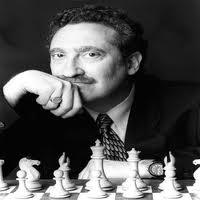
Pandolfini's Puzzler #17 - Playing by the Rules
The Professor began somewhat formally: “For those who are feeling a bit rambunctious, let’s bring up the topic of rules. Particularly, let’s talk about a rule that was changed in the last 150 years or so.”
---
“What rule is that?” Zephyr asked. “Do you mean the rule of en passant?”
---
Lucian wasn’t about to be left out. “Do you mean the rules concerning castling?” he asked.
---
“No,” the Professor responded. “I’m not referring to castling or en passant. The rules on those two conceptions, for the most part, go back further than 150 years. No, I’m talking about the Touch-Move Rule. Do you know what that is?"

---
“Yes, I do,” Zephyr interjected. “It’s the rule where if you touch a piece you have to move it.”
---
Not to be outdone, Lucian added, “And if you touch an opponent’s piece you have to take it.”
---
“Yes, you’re both right,” the Professor countered. “But what happens if you can’t take the enemy piece?"
---
“Or if you touch one of your own pieces, what happens if you can’t legally move it? What then? Is there a penalty?”
---
“No,” said Lucian. “I don’t think there is.”
---
“Well,” began the Professor. “In the past, in many places where chess was played, they used to impose a penalty. For example, under some conditions, if you made an illegal move, you had to move your king. Sometimes, that led to funny conclusions.”

---
“I don’t understand,” both youngsters chorused together.
---
“Let me show you what I mean,” said the Professor. “Take the following game. Supposedly, it was played by two German masters in the late 1800s.
---
“White began with 1. e4 and Black countered with 1…d5. Do you know what that opening is called?”
---
“That’s the Scandinavian Defense,” Lucian asserted.
---
“True,” said Zephyr, “but some people call it the Center Counter Defense.”
---
“You’re both correct,” said the Professor happily. “Let’s get back to our game. White now continued 2. exd5 and Black took back, 2…Qxd5.”
---
“What are the chief features of this defense?”
---
Lucian spoke up first. “On the positive side, Black’s queen is out there, able to attack things.”
---
Zephyr had to say something. “Yes, but on the negative side, White can develop at the queen’s expense, getting a piece out and gaining time.”
---
“Once again, you’re both correct,” the Professor agreeably retorted. “And what would be the best way to attack the queen and develop at the same time?”
---
In unison, both students answered with the same move: “Knight to c3,” they loudly said.

---
“Quite correct, again. And that’s what White wanted to play in our example. He wanted to play knight to c3. But that’s not what he wound up playing. Instead, he played an illegal move and was punished.”
---
Question: What illegal move do you think White played that led to his being mated next move?
---
Answer below - Try to solve Professor Pando's puzzle first!
---
“That’s funny,” said Zephyr. “But it seems to me, the way you phrased it, that White has many moves that allow mate next move.”
---
“Me too,” Lucian said under his breath.
---
Can you guess the illegal move that lost the game so quickly for White?
---
ANSWER #17
---
In the actual contest, White supposedly played 3. Bc3, thinking he had moved his knight to c3 instead of his bishop. But Bc1-c3 is illegal and impossible.
---
Back when and where this game was originally played (in Europe in the late 1800s), an illegal move could be punished by compelling the rule breaker to move the king. In this case, White had to play 3. Ke2??, allowing 3…Qe4 mate!
---
---
Take note
---
The above variation (1.e4 d5 2.exd5 Qxd5 3. Ke2 Qe4 mate) is one of the two shortest games possible. The other, of course, is the Fool’s Mate (1. f3 e5 2. g4 Qh4 mate). Ruling out general disqualification, the only ways to lose a game faster than that are (a) by resignation or (b) by time forfeit. Not too many players resign on the first move, though it has happened.
---
Time forfeiture on the first move of a game is also quite rare. It’s possibly the longest short way to lose a chess game. That is, it’s short in moves, but it’s long in time. Indeed, you have to wait a full hour for your opponent’s flag to fall. That could seem like an eternity.
RELATED STUDY MATERIAL
- Don't crash and burn because of en passant;
- But you can have some fun with en passant;
- Watch everything you ever wanted to know about the Touch-Move Rule;






